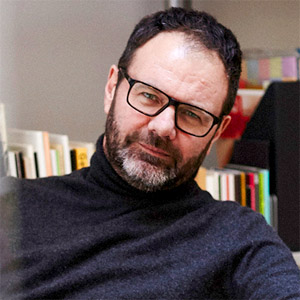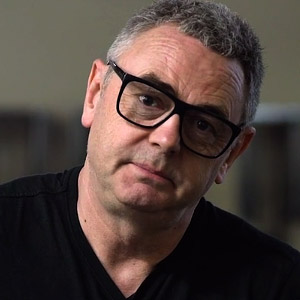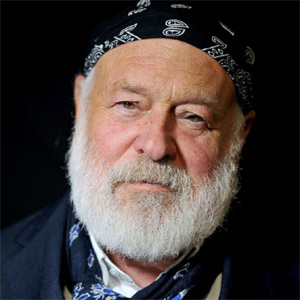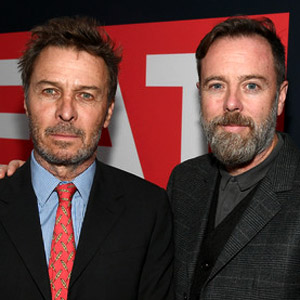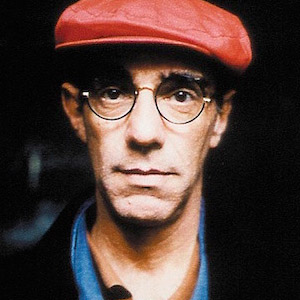Mark Farrow is a graphic designer currently residing in London. He worked with Paul West
and Rob Petrie at (3) and around 1995 founded his own company, Farrow
Design.
He worked with Pet Shop Boys since their beginnings and designed most of their record sleeves, tour merchandise and books, giving them a unique, elegant style, perfectly matching the class of Pet Shop Boys’ music. As he himself stated:
Somebody has to have an idea of what is going on marketing wise, from the point of view of selling it and how the public will perceive it, and that’s kind of what we do. We gather all of the elements that come in together and make them into a cohesive campaign.
It was Mark Farrow who created the innovative, eye-catching and award-winning designs for 1989’s Introspective, 1990’s Behaviour, 1995’s Alternative, 1997’s Somewhere and fan-club release It doesn’t often snow at Christmas. Interestingly enough, the record packaging Pet Shop Boys are probably most known from—1993’s Very orange plastic case—wasn’t created by Mark Farrow, but Pentagram design bureau.
Farrow’s company also created designs for William Orbit, Lightning Seeds, Spiritualized, Manic Street Preachers, Orbital, Cream, M People and most of late Kylie Minogue’s books and records, including her 2000’s album Light years and corresponding singles.
Going back to Pet Shop Boys area, the designs created by Farrow won several awards, including “best single package design” for Somewhere and Yesterday, when I was mad singles at the British Design & Art Direction Awards in London in 1997 and 1994, respectively. Limited edition of Alternative was nominated for best packaging at 1994’s Grammy’s Awards.
Additionally, it was Mark Farrow who contacted Pet Shop Boys with Electronic in 1989, which led to their collaboration.
At this point, though, Pet Shop Boys and Mark Farrow parted ways—last three albums with Pet Shop Boys’s involvement (Closer to heaven, Release, Disco 3 and PopArt), as well as for a couple of recent singles and other memorabilia have been designed by other people. The last collaboration with Farrow have been the 2006’s album Fundamental, and both singles from album I'm With Stupid and Minimal.
The book Sampler, written by Lawrence King, also introduced Mark Farrow and his works:
...in due course the all-pervading pop video – the sine qua non of eighties record companies – came to supplant the album cover as the most important visual platform for the record industry.
Before the end of the decade, another figure emerged who was to make an important contribution to the subject. Mark Farrow’s sleeve designs for the Pet Shop Boys ushered in an era of refinement and minimalism somewhat at odds with the prevailing trends of the time. Farrow was assisted in his pursuit of graphic purity by the Pet Shop Boys themselves, who in common with a new generation of savvy musicians and managers, insisted on clauses in their contracts which gave them control over the design of their sleeves. It is a development that has singlehandedly prevented sleeve design from atrophying, and while it cannot be said to always guarantee brilliant design, it at least allows for distinctive and rebellious sleeve art to bubble to the surface. Although there are numerous examples of fruitful partnerships between designers and musicians – Me Company and Bjork; Stylo Rouge and their early work for Blur – nowhere is this alliance of disciplines better illustrated than in the prolific relationship between Mark Farrow and the Pet Shop Boys.
Farrow remains a potent and influential force in the nineties. His beguiling packaging for Ladies and Gentleman we are Floating in Space by Spiritualised represents a return to the grandiose packaging not seen since the pre-punk era. But Farrow represents only one strand of design thinking in the pluralistic nineties. As we have seen, the new hard line adopted by the record industry stands in marked contrast to their previously sympathetic approach, and as we have also seen, the sleeve designers of the previous three decades operated in an atmosphere of encouragement and acceptance, very different from the conditions that pertain today. Yet if we examine the micro-climate in which intelligent sleeve design currently exists it is clear that it is refusing to die. Despite the loss of the vinyl sleeve, despite the rise of the music video, despite the record companies’ reliance on Spice Girls-type disposability, and despite the uncertainty coursing through the industry, sleeve design remains alive and oddly vibrant.
He worked with Pet Shop Boys since their beginnings and designed most of their record sleeves, tour merchandise and books, giving them a unique, elegant style, perfectly matching the class of Pet Shop Boys’ music. As he himself stated:
Somebody has to have an idea of what is going on marketing wise, from the point of view of selling it and how the public will perceive it, and that’s kind of what we do. We gather all of the elements that come in together and make them into a cohesive campaign.
It was Mark Farrow who created the innovative, eye-catching and award-winning designs for 1989’s Introspective, 1990’s Behaviour, 1995’s Alternative, 1997’s Somewhere and fan-club release It doesn’t often snow at Christmas. Interestingly enough, the record packaging Pet Shop Boys are probably most known from—1993’s Very orange plastic case—wasn’t created by Mark Farrow, but Pentagram design bureau.
Farrow’s company also created designs for William Orbit, Lightning Seeds, Spiritualized, Manic Street Preachers, Orbital, Cream, M People and most of late Kylie Minogue’s books and records, including her 2000’s album Light years and corresponding singles.
Going back to Pet Shop Boys area, the designs created by Farrow won several awards, including “best single package design” for Somewhere and Yesterday, when I was mad singles at the British Design & Art Direction Awards in London in 1997 and 1994, respectively. Limited edition of Alternative was nominated for best packaging at 1994’s Grammy’s Awards.
Additionally, it was Mark Farrow who contacted Pet Shop Boys with Electronic in 1989, which led to their collaboration.
At this point, though, Pet Shop Boys and Mark Farrow parted ways—last three albums with Pet Shop Boys’s involvement (Closer to heaven, Release, Disco 3 and PopArt), as well as for a couple of recent singles and other memorabilia have been designed by other people. The last collaboration with Farrow have been the 2006’s album Fundamental, and both singles from album I'm With Stupid and Minimal.
The book Sampler, written by Lawrence King, also introduced Mark Farrow and his works:
...in due course the all-pervading pop video – the sine qua non of eighties record companies – came to supplant the album cover as the most important visual platform for the record industry.
Before the end of the decade, another figure emerged who was to make an important contribution to the subject. Mark Farrow’s sleeve designs for the Pet Shop Boys ushered in an era of refinement and minimalism somewhat at odds with the prevailing trends of the time. Farrow was assisted in his pursuit of graphic purity by the Pet Shop Boys themselves, who in common with a new generation of savvy musicians and managers, insisted on clauses in their contracts which gave them control over the design of their sleeves. It is a development that has singlehandedly prevented sleeve design from atrophying, and while it cannot be said to always guarantee brilliant design, it at least allows for distinctive and rebellious sleeve art to bubble to the surface. Although there are numerous examples of fruitful partnerships between designers and musicians – Me Company and Bjork; Stylo Rouge and their early work for Blur – nowhere is this alliance of disciplines better illustrated than in the prolific relationship between Mark Farrow and the Pet Shop Boys.
Farrow remains a potent and influential force in the nineties. His beguiling packaging for Ladies and Gentleman we are Floating in Space by Spiritualised represents a return to the grandiose packaging not seen since the pre-punk era. But Farrow represents only one strand of design thinking in the pluralistic nineties. As we have seen, the new hard line adopted by the record industry stands in marked contrast to their previously sympathetic approach, and as we have also seen, the sleeve designers of the previous three decades operated in an atmosphere of encouragement and acceptance, very different from the conditions that pertain today. Yet if we examine the micro-climate in which intelligent sleeve design currently exists it is clear that it is refusing to die. Despite the loss of the vinyl sleeve, despite the rise of the music video, despite the record companies’ reliance on Spice Girls-type disposability, and despite the uncertainty coursing through the industry, sleeve design remains alive and oddly vibrant.
